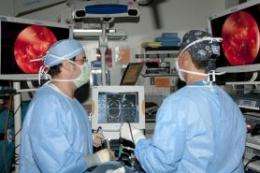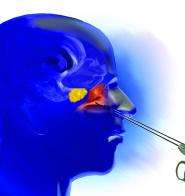UA surgeons remove brain tumors through nose

(PhysOrg.com) -- An innovative surgical technique now performed at University Medical Center involves removing skull base brain tumors entirely through the nose and sinuses without incisions to the face or skull. The procedure reduces recovery time from weeks or months to days.
An innovative surgical technique now performed at University Medical Center combines the skills of otolaryngology (ear, nose and throat surgery) and neurosurgery by removing skull base brain tumors entirely through the nose and sinuses without incisions to the face or skull.
Previously, neurosurgeons had to perform the operation by splitting the facial skeleton or peeling back the scalp and removing the skull on the forehead.
"This ‘through-the-nose approach' avoids the need for any facial incisions or a craniotomy, so complications are decreased, recovery is faster and patients are spared unsightly incisions," said Dr. Alexander Chiu, chief of the Division of Otolaryngology – Head and Neck Surgery at the University of Arizona Department of Surgery.
During the procedure, the endoscope is inserted through the nose and sinuses to directly reach the tumor, without manipulating the brain or important nerves. The tumor and surrounding area are brightly lit by the endoscope, which has a tiny camera that sends real-time video images to a large screen. Specially designed surgical tools are inserted next to the endoscope to dissect and remove the tumor.
Throughout the operation, surgeons have an excellent view of surrounding tissue, helping them to preserve important nerves and arteries that control vision and other functions. Because the brain is not disturbed, the recovery time after surgery typically is days, instead of weeks or months.
The surgery also incorporates UMC's BrainLab Neuronavigation, a computer-assisted guided imaging machine. "It acts like a GPS system to help us locate and map the tumor," Chiu said.
A nationally known expert in endoscopic and minimally invasive techniques to remove benign and malignant tumors of the nose, sinuses and skull base, Chiu, who joined the UA in October, and Dr. Michael Lemole, chief of the UA Division of Neurosurgery, recently performed the endonasal endoscopic skull base brain surgery on Rudolph Benitez of Tucson.

It all began for Benitez with a dramatic change in his vision.
"I've been treated for glaucoma for the past 20 years," Benitez said. "But recently my eyesight changed, and it was clear this wasn't just the glaucoma. I was referred to Dr. Lemole, who did a CT scan and found a quarter-inch tumor pressing on my optic nerve. Without surgery I would lose my eyesight."
Although tumors of the pituitary gland generally are benign and do not spread to the rest of the body, they can create multiple functional problems, including blindness and pressure on the brain.
"Dr. Lemole made me feel pretty confident about the surgery," Benitez said. "He went into detail about everything. He did a wonderful job of explaining it all."
Benitez sailed through the procedure with little discomfort and no visible scars. Benitez's wife, Bobbie, also was impressed by how smoothly it all went. "When I went in to see Rudy in the recovery area, I was so surprised. There was no change at all in his appearance, no sign that he'd just had surgery. It just looked like he had woken up from a deep sleep."
Chiu and Lemole have established the Center for Sinonasal and Skull Base Tumors in the department of surgery at the UA College of Medicine, the only center of its kind in the Southwest.
They recently were joined by Dr. Stephen Goldstein, associate professor of surgery, Division of Otolaryngology – Head and Neck Surgery. Goldstein is a highly skilled facial plastic and reconstructive surgeon.
The project also enlists the talents of a multidisciplinary team of surgeons, radiation oncologists and medical oncologists who together offer leading-edge and minimally invasive treatments for benign and malignant tumors of the nose, paranasal sinuses and skull base.
"Whenever feasible, we'll employ minimally invasive approaches through the nasal passages," said Lemole. "The endoscope offers us superior visualization over other techniques, such as the operating microscope. It allows us to ‘see around corners' to make sure no tumor remains and critical structures are intact
"By working with multiple specialties in neurosurgery, otolaryngology and oculoplastic surgery, we can reach virtually all areas of the brain and skull base using advanced skull base techniques. A multidisciplinary team ensures that patients receive the highest degree of specialized and comprehensive care available," he explained.
Dr. Rainer Gruessner, professor and chairman of the UA department of surgery, added, "The center combines two divisions within the department to provide the collaborative approach to care needed for patients with complex diseases or disorders of the head and neck. This approach is the future of surgical care. Our goal is to establish the leading center for skull base surgery in the Southwest."
















